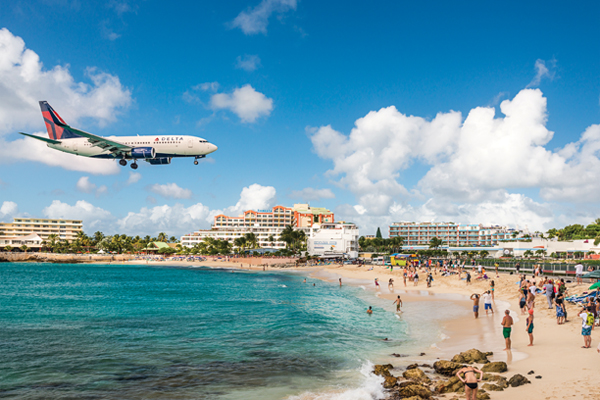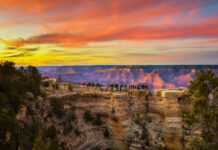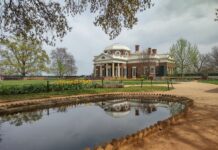
Then we were like, “Where is St. Martin?”
I mean, it had one of those “St.” names like so many Caribbean islands do, so it was probably awesome. But what if it was one of those resort-y places full of partying college students or some all-inclusive spot with bland drinks and a one-size-fits-all swimming pool like at a Best Western? (Not that there’s anything wrong with that, if it’s your thing.)
This island trepidation was exactly what had sent our search for a wedding destination off the rails the year before. There are so many islands. Some must be nice, but what if you picked the wrong one? Next thing you know, your grandma is getting belly-bumped into the swimming “lagoon” by a shirtless drunk guy named Jordan.
Neither my husband nor I come from families that use seasons as verbs. We have never “summered” or “wintered” anyplace, and we don’t know many people to ask for advice about fancy vacations. But we were game. We were onboard. Don’t look a gift timeshare in the mouth, I always say.
We began to refer to the upcoming trip as Honeymoon 2: Electric Boogaloo. I was skeptical about whether it would compare to the original Honeymoon the year before in Tulum, Mexico, where we went because friends had been there and raved about it. The sequel is rarely as good as the original.
It never has been such a pleasure to be dead wrong.
St. Martin, it turns out, is midway between Puerto Rico and Guadeloupe in the heart of the Caribbean. Like many islands, it was invaded, settled, pillaged, governed and abandoned by a succession of colonial powers over the past several hundred years. As a result, it now has a French side (Saint-Martin) to the north and a Dutch side (Sint Maarten) to the south, together known as St. Martin/St. Maarten; each exists as part of its respective “parent” nation. This means residents and visitors alike drive across border checkpoints on its 34 square miles, European Union flags waving against a backdrop of volcanic hills and turquoise sea. To get there, you fly into Princess Juliana Airport in Sint Maarten.
There are 37 beaches, each with a slightly different character, a slightly different grain of sand, a slightly different degree of calm surf. We drove in our rental car to a different one each day. Both strategies had been recommended: renting a car and using it. And we could see why. A car is really the only way to get around, and there’s so much to see in such a small place. Plus, the nature of the rocky coastline means that most hotels are not on beachfront property.
 Many beaches have restaurant/snack bars where you can rent umbrellas and get tableside service all day for about $25. You can pay in dollars or euros. We made a ritual of ordering a bucket of bottles of Carib beer and fresh guacamole. Many also serve fresh seafood. Some beaches had waves, while others’ water was flat as glass, but it was crystal-clear at all of them, and you can snorkel and see colorful little fish. We brought our own masks, but many places offer rentals, and we had a great time taking pictures with an underwater camera, something to consider if you go. At the end of each day, as we drove over volcanic mountain passes, salt on our skin, the sun setting pink, we’d say, “This was my favorite beach so far” and “No, this one was the best.”
Many beaches have restaurant/snack bars where you can rent umbrellas and get tableside service all day for about $25. You can pay in dollars or euros. We made a ritual of ordering a bucket of bottles of Carib beer and fresh guacamole. Many also serve fresh seafood. Some beaches had waves, while others’ water was flat as glass, but it was crystal-clear at all of them, and you can snorkel and see colorful little fish. We brought our own masks, but many places offer rentals, and we had a great time taking pictures with an underwater camera, something to consider if you go. At the end of each day, as we drove over volcanic mountain passes, salt on our skin, the sun setting pink, we’d say, “This was my favorite beach so far” and “No, this one was the best.”
It should be noted, for those who care, that beaches on the French side permit women to go topless, while Dutch-side beaches don’t. The majority of women on the French side do wear tops, but there is certainly a smattering of boobs. Forecast: partly booby.
Because we are both in our 40s and have bones that are like breakdancing—lots of popping and locking—we have lately taken up yoga. So we sought out some drop-in classes that we could attend in the mornings before our beach adventures. At a studio called Joga on the Dutch side, we interacted with our classmates, primarily locals, striking up conversations easily. Just about everyone we met—at the studio and elsewhere—was bilingual in Dutch and English or French and English. However, few spoke both Dutch and French, perhaps an illustration of how distinct the two sides are culturally. When I’d ask, “Do you also speak [the other language]?,” people would sometimes respond with wide, alarmed eyes, as if I’d inquired if they’d ever participated in Olympic archery or something. Then they’d laugh and remark how impossible that was.
One woman we met at the yoga studio turned out to be the mother of a famous local chef about whom we’d read en route in an in-flight magazine. She encouraged us to come to his nouveau-Caribbean cuisine restaurant, Temptation, that night on the Dutch side. We did, and we were so glad. Every course was like our “this-one-is-my-favorite” beach-photos exchanges. The dessert was a chocolate crumble served in a terra cotta flowerpot, with the chocolate the “dirt” and a large sprig of mint the “flower.” It was creamy and chocolatey and minty in a way that makes you eat slowly and savor. If you’re interested in Temptation, make reservations well in advance, especially during the high season, which runs from December through April.
Temptation served as our fine-dining experience, but there were other meals when we tried casual, local fare. Yvette’s Restaurant in Quartier-d’Orleans, a seaside town on the French side, had gotten rave reviews. We got lost trying to find it, going up and down the dark main road. There aren’t many streetlights, and we simply hadn’t spotted the side road we kept passing. Once there, though, we found ourselves in a gingerbread-trimmed Creole cottage with wood paneling inside and plastic tablecloths. There may have been some doilies involved. There was a long wait, but it was worth it. Dishes included conch chowder and Creole red snapper and johnnycakes.
One of the weirdest things that we discovered about St. Martin is that it is the home of a small museum called the That Yoda Guy Movie Exhibit. It turns out that Nick Maley, one of the special effects artists who created Yoda, lives on the island. We are both Star Wars nerds, so this wasn’t something we could miss. On the day we visited, no cruise ships had come into port in Philipsburg, the museum’s location in the Dutch side’s capital. When we got there, the actual Yoda Guy was in the place by himself, when normally we’d have been greeted by a clerk. We paid our admission and spent a couple hours studying the cast molds of famous actors’ faces and original photos and scripts from the SW film franchise. He sensed our enthusiasm and spent time talking to us and posing for photos. It’s possible he was just bored, but we felt pretty special.
When we wandered back outside, it was disorienting to be in the Caribbean sun after all that time indoors. The atmosphere on St. Martin can sometimes be like that, producing surprising juxtapositions. On this occasion, we were amid this Caribbean island topography enjoying a bit of Hollywood. On another, we sat in a bistro eating pain au chocolat as only the French can make, while enormous brown pelicans swooped over turquoise Simpson Bay in search of their breakfasts.
Now that we know that a sequel can be better than the original, we’re eager to go back. Maybe for Honeymoon 3: The Awakening.




